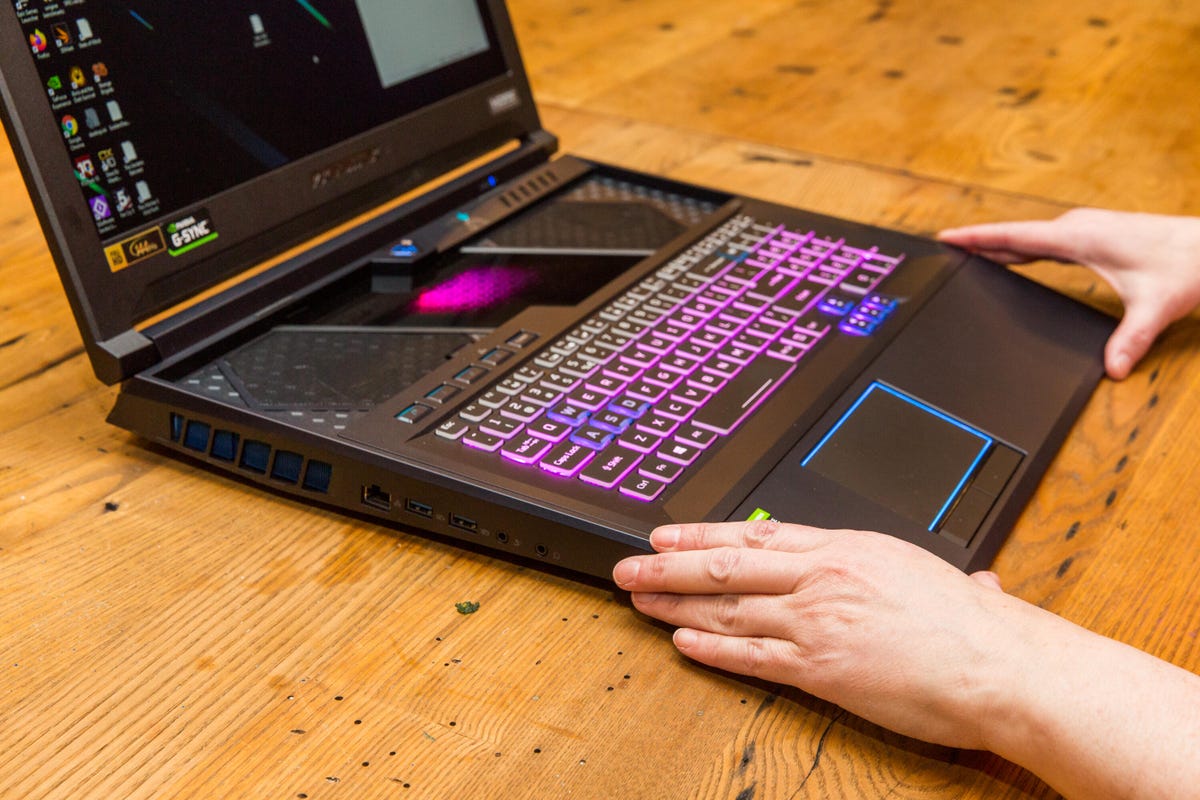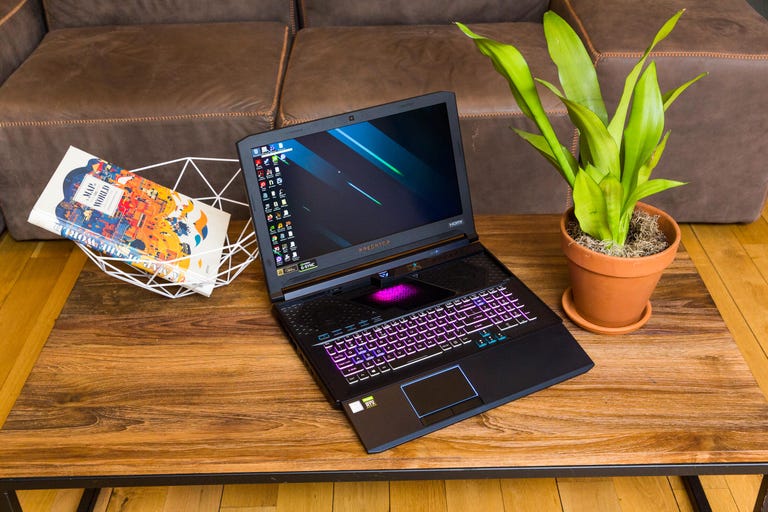 Why You Can Trust CNET
Why You Can Trust CNET Acer Predator Helios 700 review: Plenty of gaming power plus a clever keyboard
The laptop's sliding keyboard ups its cool quotient.

The Helios 700's keyboard deck slides out to provide titling wrist rests, revealing dual fans that enable the laptop's Extreme CPU and GPU overclocking modes.
If you're looking for a gaming laptop that will blow your socks off, the Acer Predator Helios 700 is it -- on multiple levels. From its innovative sliding keyboard to its class-leading performance or its back-breaking weight, to its vacuum-loud fans when maxed out, the Helios 700 definitely makes a big impression. Just not big enough to scream "buy me!"
Like
- Innovative slide-out keyboard.
- Fast.
Don't like
- Heavy.
- Bad battery life even for a gaming laptop.
- Open hinge area allows dust in
Acer doesn't offer a lot of configuration options for the Helios 700. There are three models, all of which have the same 17-inch 1080p 144Hz G-sync screen. The $2,200 base model has an Intel Core i7-9750H processor, Nvidia GeForce RTX 2070 graphics, 16GB RAM, a 512GB SSD and an Intel Core i9-9980HK processor, and another $300 bumps you to an RTX 2080. The top model -- which is $1,000 more than the middle child -- jumps to an overclockable Intel Core i9-9980HK CPU, 32GB RAM and a 1TB SSD.
In the UK, the configurations all have more storage, supplementing the same capacity SSDs with 1TB or 2TB hard drives; prices there start at £2,500 and run through £3,500. The only 17-inch Predator laptop available in Australia seems to be the Triton 900.
The middle model is really the sweet spot for this laptop. Yes, the i9 will perform better than the i7, and it has more memory and storage, but it's not necessarily worth the extra $1,000 (or £1,000) for the performance improvement, unless you play a lot of games that effectively balance CPU and GPU loads (such as Shadow of the Tomb Raider).
Acer Predator Helios 700
| Price as reviewed | $3,499.99; £3,499.99 |
|---|---|
| Display | 17.3-inch 1,920x1,080 144Hz |
| PC CPU | 2.4GHz Intel Core i9-9980HK |
| PC Memory | 32GB 2,666MHz DDR4 |
| Graphics | Nvidia GeForce RTX 2080 |
| Storage | 1TB SSD |
| Ports | 2 x USB-C (1 x Thunderbolt), 3 x USB-A, 1 x HDMI 2.0b, 1 x DisplayPort 1.4, headphone, mic |
| Networking | Killer Wi-Fi 6 AX1650x , Bluetooth 5.0, Gigabit Ethernet |
| Operating system | Microsoft Windows Home (1909) |
| Weight | 10.6 lbs./4.8 kg |
In most ways it's a generic Predator design, with one big exception: the entire keyboard deck slides toward you, tilting the wrist rest/touchpad section down and revealing the dual fans. That allows the system to remove a lot more heat from inside the system and is necessary for the Extreme CPU and GPU overclocking modes. Exposing the fans also means they get loud when maxxing out. Really loud. The loudest fans I think I've ever heard, necessitating that I raise the volume in my headphones to hear dialog.
On one hand, pulling out the keyboard makes it feel a lot more like a real standalone model with a slanted wrist wrest, which makes it more comfortable than most laptops for long typing sessions. It also means that when it's running hot, it's not transmitting heat up through the keyboard, although the Predator's rubbery keycaps prevent them from getting hot as well.
But to me, it feels like it's hard to find a comfortable way to arrange the laptop and a mouse with mousepad for gaming with the built-in display, because that section gets in the way. And it's a little odd feeling because when the wrist rest is tilted, the touchpad is also tilted, while the keyboard deck remains level.
The design also makes this a thick, heavy laptop -- heavier even than the Alienware Area-51m and the Origin PC Eon17-X, both of which have faster desktop i9-9900K processors in them. The Predator weighs 10.6 pounds, but you can't really use it unplugged for more than a couple of hours, so you have to schlep the 2.4 lb. (1.1kg) AC adapter as well.
There's also a gap below the display when the laptop's closed, which lets in a lot of dust if you're in a seriously particle-ridden environment (like mine). On the upside, though, it has an illuminated border around the touchpad, a still-too-uncommon feature that's important for those of us who spend a lot of time in the dark.
For a big, heavy 17-inch laptop with a similarly innovative design, I prefer the Predator Triton 900 more; its rotating display is a lot more flexible, not to mention better (this one's a run-of-the-mill 144Hz IPS G-sync model with a sub-sRGB color gamut). It's also a lot more striking looking, compensating a bit for the old-fashioned wide bezels that make the Helios 700 look dated and clunky. Unfortunately, that one tops out at an i7-9750H and isn't quite as fast if you also need the speed.
Speaking of speed, the Helios 700 is the zippiest we've tested with the exception of i9-9900K-based models; no surprise given that the laptop H series processors have a lower power envelope than their desktop analogs. (At its maximum overclocking in the Helios, the processor draws about 107 watts.) But you don't really gain much by running in Extreme mode for gaming -- the biggest boost seems to be on RTX ray tracing (as measured by 3DMark Port Royal), and that's only about 10%. You do have the option of using different overclocking settings for the CPU and GPU.
Geekbench 4 (multi-core)
Cinebench R15 CPU (multi-core)
3DMark Fire Strike Ultra
3DMark Port Royal (RTX)
Shadow of the Tomb Raider gaming test
System configurations
| Acer Predator Helios 700 (PH717-71) | Microsoft Windows 10 Home (1909); 2.4GHz Intel Core i9-9980HK; 32GB DDR4 SDRAM 2,666MHz; 8GB Nvidia GeForce GTX 2080; 1TB SSD |
|---|---|
| Acer Predator Triton 900 | Microsoft Windows 10 Home (64-bit); 2.6GHz Intel Core i7-9750H; 32GB DDR4 SDRAM 2,666MHz; 8GB Nvidia GeForce RTX 2080; 1TB SSD |
| Alienware Area-51m | Microsoft Windows 10 Home (64-bit); 3.2GHz Intel Core i9-9900K; 32GB DDR4 SDRAM 2,400MHz; 8GB Nvidia GeForce RTX 2080; 1TB SSD + 1TB HDD 5,200 RPM |
| Asus ROG Zephyrus GX701 | Microsoft Windows 10 Pro (64-bit); 2.2GHz Intel Core i7-8750H; 24GB DDR4 SDRAM 2,666MHz; 8GB Nvidia GeForce RTX 2080 with Max-Q Design; 1TB SSD |
| MSI GS75 Stealth (8SG) | Microsoft Windows 10 Home (64-bit); 2.2GHz Intel Core i7-8750H; 32GB DDR4 SDRAM 2,666MHz; 8GB Nvidia GeForce GTX 2080 with Max-Q Design; 512GB SSD |
| Origin PC EON17-X (2019) | Microsoft Windows 10 Home (64-bit); 3.6GHz Intel Core i9-9900K; 16GB DDR4 SDRAM3GHz; 8GB Nvidia GeForce RTX 2080; 500GB SSD + 2TB HDD |
| Razer Blade Pro 17 | Microsoft Windows 10 Home (64-bit); 2.6GHz Intel Core i7-7750H; 16GB DDR4 SDRAM 2,666MHz; 8GB Nvidia GeForce RTX 2080 with Max-Q Design; 512GB SSD |


